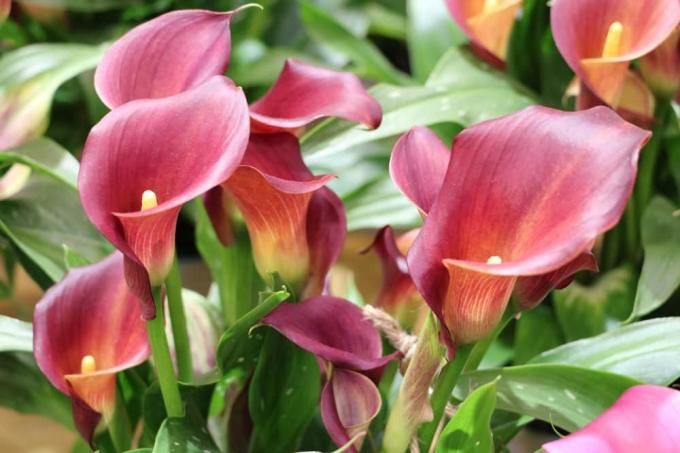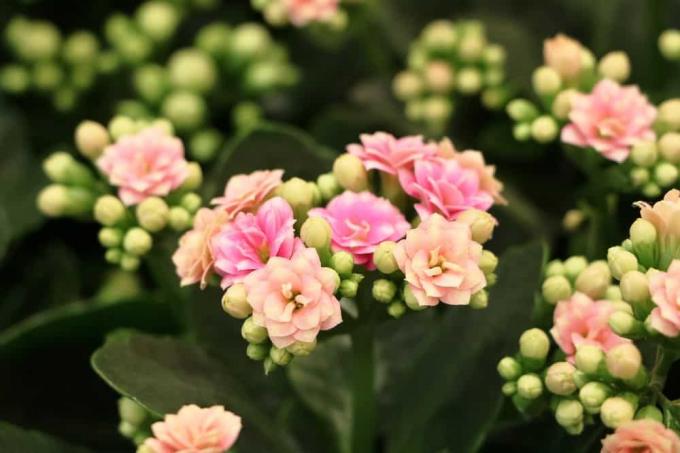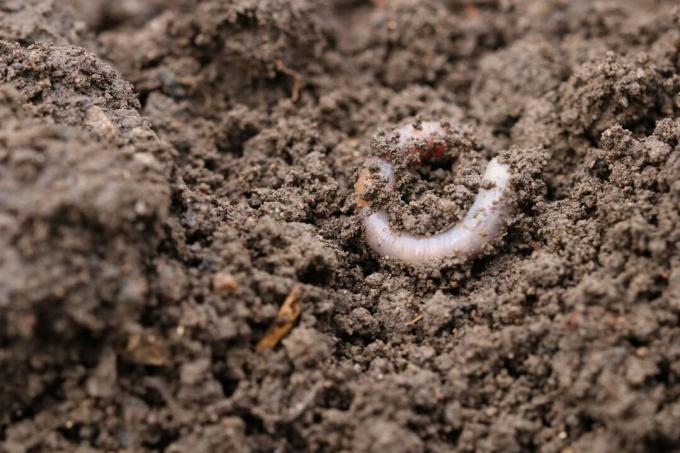

Table of contents
- relatives of earthworms
- Harmful or not?
- It works without chemicals
- Germ and worm free soil?
- Repot step by step
- Collecting is also possible
Worms in the potting soil have a repulsive effect. The mostly colorless or white small animals trigger feelings of disgust and are regarded as vermin. They are not per se, but they are not always good for houseplants either. So it's perfectly understandable if you want to get rid of the worms. However, chemicals are not necessary, the worms can simply move out.
relatives of earthworms
If worms are noticed in the potting soil, the disgust is usually great at first. The small creatures are between four and thirty millimeters long, often transparent, but sometimes milky white or brown-grey. Most of these belong to the same family as earthworms and also feed like them: they migrate dead plant parts under the ground, eat them up and fertilize with their excretions Floor. However, the range of dead plant parts in a well-kept flower pot or tub indoors is very limited compared to outdoors. It can therefore happen that the small worms eat the roots of the plants at some point due to a lack of food. And that harms the plant.
Most worms belong to the Enchytraeidae family. These worms are usually between five and thirty millimeters in size and white or yellowish-brown when fully grown. However, there are also completely transparent specimens. Here it is worth overcoming your disgust and taking a closer look at the animals: the internal organs can be seen through the transparent body and the worms' digestive tract can be seen. This is a fascinating insight into nature that is otherwise only granted to biologists.
In nature, the worms eat the dead plant parts and also digest the bacteria contained in them before they can infect the surrounding plants. Their excrement fertilizes the soil. Their movements through the soil loosen and aerate the soil, water can penetrate and seep away easily, and the soil is evenly permeated with humus. This means that the animals are really welcome outdoors and in pots outdoors and are a great help for every gardener. Just like earthworms, which sometimes get into the flower pot with the open-air soil.
Harmful or not?
In the window box or in the tub outside, where there are often dead leaves and also an unwanted weed grows and is plucked out every now and then, worms do no harm at first. Things are different in a closed room: Here, no parts of plants land on the ground that would have to be removed by the cleaning service (because that’s what worms are in the end). They would therefore quickly nibble on the indoor plants due to lack of food. Healthy, strong plants can take the loss of a few hairy roots just fine, but when the worms multiply, it quickly becomes a real problem. Because then it does not remain with a few hair roots, but many roots are eaten. However, the plant needs the roots to absorb the nutrients from the potting soil together with the irrigation water. If the roots are eaten off, the plant will starve and die of thirst. Accordingly, the worms in the flower pot are not pests per se, but they are a threat to the plants in closed rooms.
It works without chemicals

Special sprays, tinctures, and other chemicals, sometimes mixed into the soil, are available to combat many different organisms that can potentially harm plants. This is not necessary in the case of worm infestation. It is sufficient if the plant is carefully removed from the old potting soil and placed in new soil and a new, cleaned pot. Incidentally, this is also recommended if worms are crawling around in the potting soil on the balcony or in the buckets in front of the front door. Not because they would damage the plants too much, but because worms trigger extreme disgust in most people.
Germ and worm free soil?
Anyone who is disgusted by worms in the potting soil will want to make sure that after repotting there are guaranteed to be no more living beings in the potting soil. There is more or less sterile soil to buy. Other soil can always contain small living creatures, because this soil is considered to be their natural habitat and it comes naturally to garden centers and retailers. It's fairly easy to get regular potting or garden soil reasonably free of animals and other unwanted creatures:
- Preheat the oven to 220°C.
- Line a sufficiently deep baking tray with baking paper.
- Scatter the desired amount of soil over it.
- Place the baking sheet in the oven and heat for about 15 to 20 minutes. Best under supervision in case something catches fire in the ground.
With this method, most fungal spores do not survive, many bacteria are destroyed, and worms cannot tolerate this heat either. The slightly earthy smell that spreads through the apartment is normal, as long as nothing is on fire everything is fine. Alternatively, the soil can be sterilized in the microwave.
- Loosely place slightly damp (not wet) soil in a cotton bag.
- Knot the bag and place in the center of the microwave.
- Cook through for about four to five minutes on a 900 watt appliance. Under supervision in case the bag catches fire.
- Leave to cool and carefully remove from the bag.
Sterilizing in the microwave is less power-intensive than the oven method and not as time-consuming. However, even in this case, the kitchen will smell a bit like hot earth, which cannot be avoided.
Repot step by step
In preparation, everything that is needed for repotting should be ready. Are needed:
- Houseplant in the old pot
- new pot
- enough new soil
- some gravel or seramis
- a dustbin for the old earth
- Gloves and a small shovel
- lots of newspaper
First, the work surface is covered with newspaper. This makes cleaning easier after the work is done. Then the gloves are put on and the required utensils are provided on the newspaper. The new pot is filled with some gravel or seramis, and then some potting soil. A depression is pressed into the middle so that the plant can find space here with the root ball. The remaining potting soil is provided on the newspaper. The houseplant is now carefully grabbed by the stem, as close to the ground as possible (worms can't bite through gloves, so don't worry).

Now carefully pull up and hold the pot with your other hand. The plant often detaches itself from the soil and can be removed. If this is not the case, the soil can be lured a little with the shovel on the edge of the flower pot. The plant is now carefully held over the trash can so that the soil can be shaken off the root ball as completely as possible. Shake gently so as not to damage the plant. If necessary, you have to help with the second hand: As much soil as possible should be stripped from the roots, but without damaging the roots.
Now the plant can be carefully placed in the new pot with the root ball. If the plant is somewhat aligned, more potting soil is poured in from the outside and lightly pressed down. But be very careful, the soil should only hold the plant in place, not cement it in place. Once the plant is stable, the flower pot can be filled to the desired height. A little water will help the plant extend its roots into the new soil. The remaining soil from the old flower pot can be disposed of in the trash can together with the worms.
But the soil can also simply be dumped in the garden: the worms do useful work here and do no harm. The old flower pot must now be cleaned so that no worms or their eggs or larvae stick to the pot. Warm water and a sponge do a good job. Finally, the workplace is cleaned up, the newspapers are collected and the dirt on them is shaken off. The newspapers themselves can be disposed of with the waste paper, the soil belongs in the residual waste or, if necessary, in the organic waste bin (the individual German municipalities have different regulations).
Collecting is also possible
If you are not disgusted by the worms, you can simply accumulate them. To do this, the houseplant and its pot are placed in a large vessel with water. The worms cannot breathe in the water, they come to the surface and can now be easily collected. Exposed in the garden, they can find a new habitat there and do a good job for the plants.
Often, however, you do not catch all the worms when collecting them. Sometimes eggs, larvae or particularly young specimens remain undiscovered, so that after a while worms can be observed in the potting soil again. Then the collection must be repeated. For the benefit of the houseplant, the water should be able to drain completely from the flowerpot after this action. You don't have to water it first, the plant has enough water.
Some plants can also tolerate short periods of extreme drought – but the worms cannot. Therefore, it can also work to simply not water the plant for a while and to dry out the worms. However, this requires a bit of intuition, because from the outside you cannot see how dry the soil is in the middle of the pot. And if you wait too long to water, you risk a withered houseplant. By the way, both enchytraea and earthworms are hermaphrodites. The worms are male and female at the same time, so that they can in principle reproduce as long as only two worms are present.
 garden editorial
garden editorial I write about everything that interests me in my garden.
Learn more about floor care

Digging up the garden: 13 tips for lawns and beds
Whether it makes sense to dig up beds or lawns is discussed in different ways. Once you have decided on this measure, our tips will help you to organize work in the garden effectively.

Pine bark: suitable for which plants?
Pine bark is a type of mulch that is gaining popularity among many garden owners due to its color and properties. Before purchasing, the question often arises as to which plants the bark mulch is suitable for. This question is justified because of the origin of the pine.

Which soil to choose for elephant foot?
The right substrate is crucial for the elephant's foot and should therefore be chosen well. Read here which soil is best suited for the Beaucarnea recurvata!

Expanded clay as a water reservoir: The alternative to earth?
Expanded clay is known to many as a substrate for hydroponics or as drainage in pots. Due to its properties, the clay granulate is suitable as a substrate in many different areas and can replace soil. The granules have long been an indispensable basis for green roofs.

Potting soil: Mix the potting soil yourself
Potting soil has to meet special requirements. It can therefore often make sense to mix potting soil yourself. This comes with several advantages. But what do you have to pay attention to? The guide below shows how to do it.

pH value in the soil: 15 tips for measuring & regulating
If the pH of the garden/plant soil is suboptimal, this can lead to serious plant damage. We show what options there are for measuring and regulating.

